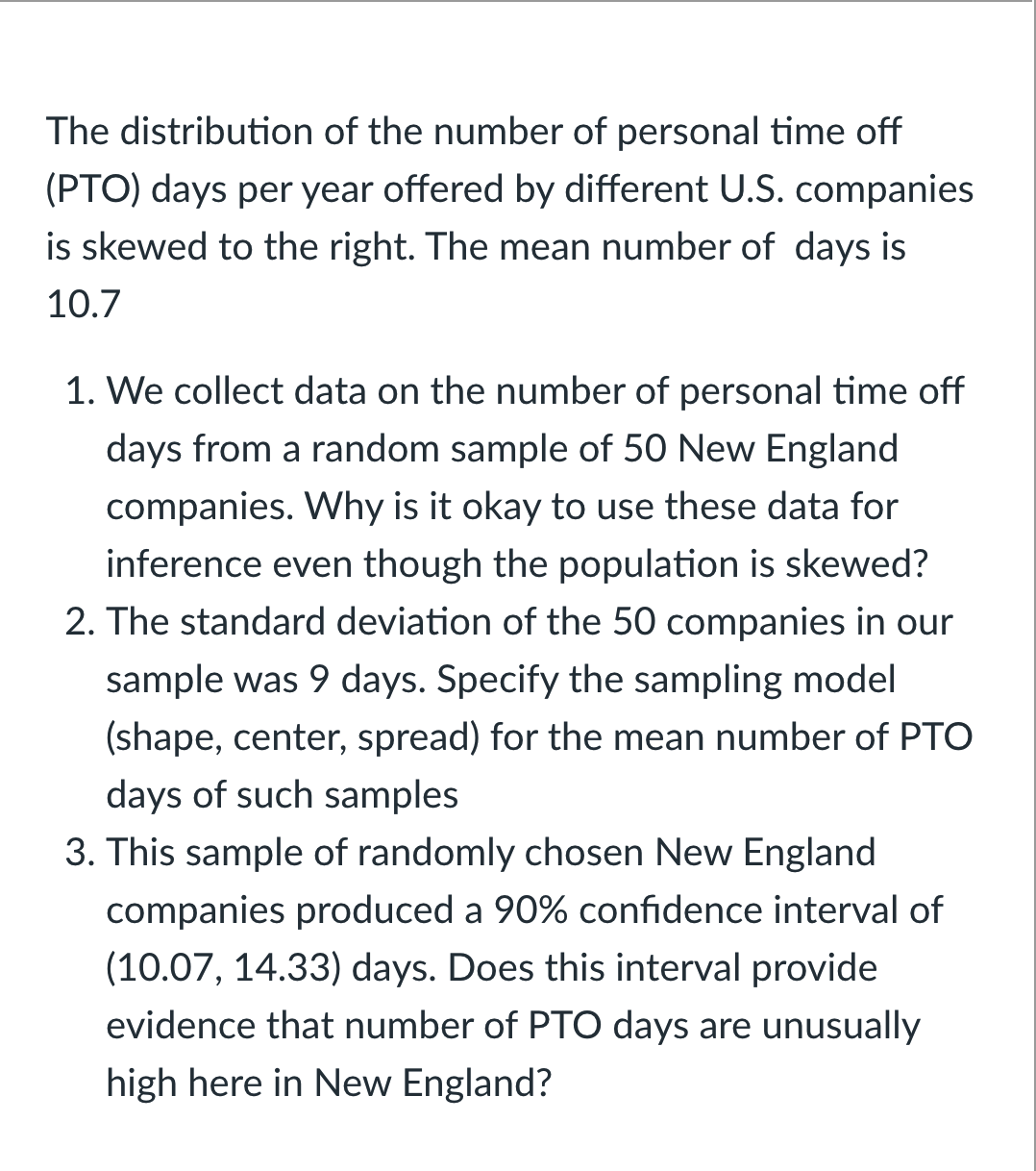The distribution of the number of personal time off (PTO) days per year offered by different U.S. companies is skewed to the right. The mean number of days is 10.7 1. We collect data on the number of personal time off days from a random sample of 50 New England companies. Why is it okay to use these data for inference even though the population is skewed? 2. The standard deviation of the 50 companies in our sample was 9 days. Specify the sampling model (shape, center, spread) for the mean number of PTO days of such samples 3. This sample of randomly chosen New England companies produced a 90% confidence interval of (10.07, 14.33) days. Does this interval provide evidence that number of PTO days are unusually high here in New England?
The distribution of the number of personal time off (PTO) days per year offered by different U.S. companies is skewed to the right. The mean number of days is 10.7 1. We collect data on the number of personal time off days from a random sample of 50 New England companies. Why is it okay to use these data for inference even though the population is skewed? 2. The standard deviation of the 50 companies in our sample was 9 days. Specify the sampling model (shape, center, spread) for the mean number of PTO days of such samples 3. This sample of randomly chosen New England companies produced a 90% confidence interval of (10.07, 14.33) days. Does this interval provide evidence that number of PTO days are unusually high here in New England?
Glencoe Algebra 1, Student Edition, 9780079039897, 0079039898, 2018
18th Edition
ISBN:9780079039897
Author:Carter
Publisher:Carter
Chapter10: Statistics
Section10.4: Distributions Of Data
Problem 19PFA
Related questions
Question
I need help reviewing this book problem. Why in this case is a skewed sample acceptable? What is the sample model's shape, center, and spread? and does the sample of new England companies provide evidence that the number of PTO days in New England are usually high?

Transcribed Image Text:The distribution of the number of personal time off
(PTO) days per year offered by different U.S. companies
is skewed to the right. The mean number of days is
10.7
1. We collect data on the number of personal time off
days from a random sample of 50 New England
companies. Why is it okay to use these data for
inference even though the population is skewed?
2. The standard deviation of the 50 companies in our
sample was 9 days. Specify the sampling model
(shape, center, spread) for the mean number of PTO
days of such samples
3. This sample of randomly chosen New England
companies produced a 90% confidence interval of
(10.07, 14.33) days. Does this interval provide
evidence that number of PTO days are unusually
high here in New England?
Expert Solution
This question has been solved!
Explore an expertly crafted, step-by-step solution for a thorough understanding of key concepts.
This is a popular solution!
Trending now
This is a popular solution!
Step by step
Solved in 2 steps with 2 images

Follow-up Questions
Read through expert solutions to related follow-up questions below.
Follow-up Question
What about part two which refers to the sampling model's shape, center, and spread?
Solution
Recommended textbooks for you

Glencoe Algebra 1, Student Edition, 9780079039897…
Algebra
ISBN:
9780079039897
Author:
Carter
Publisher:
McGraw Hill

Glencoe Algebra 1, Student Edition, 9780079039897…
Algebra
ISBN:
9780079039897
Author:
Carter
Publisher:
McGraw Hill